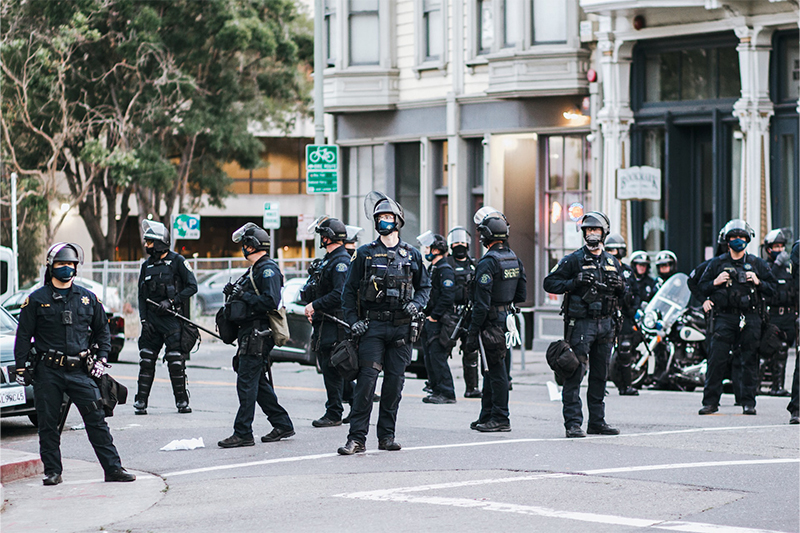
Will he or won't he?
As we learn about the criminal indictment of former President Trump, I thought it timely to share tips for civil unrest events. Companies across the United States are considering potential business disruptions and threats to their employees from political unrest. During COVID-19, it was recognized that the pandemic fueled or increased civil unrest and political instability. According to Vision of Humanity, over five thousand violent incidents occurred worldwide between July 2020 and April 2021.
Since 2020, the US experienced events like Black Live Matter and the storming of the Capital Building. Interestingly, high-peace countries experienced only a 7% reduction in business hours interrupted, while low-peace countries had a high of 23%. The data is provided by the IEP’s Business & Peace Report 2021. It is significant for crisis managers and resilience professionals because it shows how political instability can impact business operations. There are multiple actions organizations can take to prepare and respond to civil unrest to mitigate impacts.

Risk assessments anticipate continued unrest
The War in Ukraine, the most recent worst-case example of political instability, is an outgrowth of the pandemic’s impacts. Earlier, I wrote about Ukraine’s Resilience In Action, which speaks to the determination of the country’s people and businesses to continue regardless of the calamity around them. However, although assessing the likelihood proves challenging, IMF’s Reported Social Unrest Index attempts to do so. It points out that unrest was on the rise before the pandemic.
IMF economists consider the reasons for the current civil unrest tied to the rolling back of pandemic restrictions and an untenable rise in the cost of living. Social unrest risks are protests, riots, and other forms of civil disorder. From what I read, the causes of an increased likelihood of global uprisings are tied to youth unemployment, perceived inequality and corruption, climate concerns, rising global literacy, and urbanization. So, with all these challenges on our doorstep, resilience professionals must monitor risks and prepare for ongoing events.

It's only a matter of time
I expect many of you have already responded to events over the past few years. Even if your employees, assets, or operations weren’t impacted, some hours were likely spent with your threat or crisis teams preparing. If your business was fortunate not to be directly affected, with the data before us, I urge you to add this hazard to your risk register and planning.
Incidents of civil unrest doubled over the last decade. So, adding this event type to your business continuity planning is prudent. Over the past few years, I coordinated and responded to multiple events in this space. I wholeheartedly agree with a unified approach to critical event management throughout any assessment or event response. Whether it is a cyber, IT, or physical protest event, I cannot speak highly enough about the value of collaboration in preparing for crisis events. Of course, the same holds for truly collaborative crisis teams!

The value of planning for a civil unrest event
The value of planning for a civil unrest event is significant for businesses, as it can help mitigate the impact of such events and minimize the risk of harm to employees, customers, and property. By having a well-thought-out contingency plan, businesses can respond quickly and effectively in civil unrest, ensuring the safety of all involved.
Planning for civil unrest events can also help businesses minimize the disruption to their operations and maintain business continuity. By preparing in advance, companies can identify and prioritize critical functions, ensuring that essential services and products can still be delivered even during the unrest.
Moreover, planning civil unrest events can help businesses protect their reputations and maintain customer loyalty. Suppose a company is well-prepared and able to respond quickly and effectively to civil unrest. Customers are more likely to view them favorably and appreciate their commitment to safety and security.
Overall, planning for civil unrest events is critical to business risk management. It helps companies minimize the impact of such events and maintain their operations and reputation.

Steps for mitigating civil unrest events
Businesses can take several steps to prepare for civil unrest events and mitigate their impact. Here are some suggestions:
Develop a contingency plan: Businesses should create a plan outlining what to do in cases of civil unrest. The plan should include steps for securing the premises, ensuring the safety of employees, and communicating with customers and suppliers. It should be exercised if not called out directly, and an action plan should be developed if the threat arises.
Enhance physical security: Businesses should review their security measures and consider adding extra security measures such as security cameras, reinforced doors and windows, and alarm systems. It’s essential to ensure that the physical security measures are adequate and regularly maintained.
Monitor social media and news: Monitoring social media and information can help businesses stay informed about potential civil unrest events. Companies can use various tools to monitor social media and news outlets and alert employees when there is a potential threat.
Train and communicate with employees: Businesses should train employees to respond during civil unrest events. This includes training on how to stay safe, communicate with customers, and implement the contingency plan. Leadership’s support for ongoing and relevant communications to employees, contractors, vendors, and key stakeholders is vital.
Maintain adequate insurance coverage: Businesses should review their insurance policies and ensure proper coverage of civil unrest events. This includes coverage for property damage, business interruption, and liability.
Maintain strong relationships with the community: Building solid relationships can help businesses mitigate the impact of civil unrest events. This includes engaging with local organizations, supporting community events, and being responsive to community concerns.
Overall, businesses should take a proactive approach to prepare for civil unrest events and continuously review and update their contingency plans to ensure they are effective.

The days ahead will be telling
Many are concerned that violence may occur in support of the former president if his arrest happens. However, regardless of if it does, I remain hopeful about the good nature of people. If we are fortunate, cooler heads will prevail. Yet, I am a realist and understand that, at times, people’s frustration overruns good sense. Also, some seek opportunities to do harm and sew discontent for their ends.
Hopefully, my tips for civil unrest events will help you start or refresh your planning. As we know, sound planning helps alleviate adverse outcomes. It can not stop them all, but a prepared crisis team and business partners do mitigate the risk. Let me know if you have any additional suggestions in the comments below.
Did you know?
Disaster Empire blogs contain embedded links to source materials, articles of interest, videos, books, and training I recommend. Just click on the blue embedded link to access the resource.
